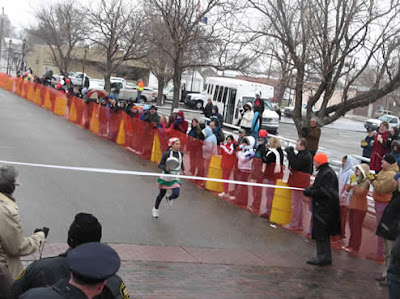It's always a good day to flip for pancakes. But if you need an excuse to celebrate pancakes, International Pancake Day is Tuesday, February 28.
It seems there's a day for every food these days. There are days delighting in doughnuts. There are days for sandwiches, hamburger and hot dogs. Pie gets more than one day. But Pancake Day is especially important in Liberal, Kansas, and Olney, England. For the past 68 years, the women of the two communities have raced down
the streets of their respective communities, flipping pancakes and
running against the clock and each other. The race is always on Shrove
Tuesday, the day before Ash Wednesday. It's the only race of its kind
in the world.
In Olney, the Pancake Race tradition dates back to 1445. Legend has it
that a woman was busy making pancakes and using up cooking fats, which
were forbidden during Lent at that time. Hearing the church bells ring
to announce the Shrove Tuesday service, she grabbed her head scarf and
ran to the church, with pancake-filled skillet in hand. In following
years, neighbors joined the race to the church. The first to arrive
collected a Kiss of Peace from the bell ringer.
 |
| Photo from the International Pancake Day Facebook page: Liberal's Billie
Warden crosses the finish line in 1950. Billie
won the local race with a time of 1:18 but lost to Olney's Florence
Callow, who finished in 1:10.4. |
The international race with Liberal began in 1950, when Liberal Jaycee President R.J. Leete saw a photo of the English race in
Time magazine and then contacted Olney, challenging their women to race against the women of Liberal.
Racers must still wear a head scarf and apron. Each runner flips
her pancake at the starting signal and again as she crosses the finish
line to prove she still has her pancake after running the 415-yard
course. The overall record stands at 37 wins for Liberal to Olney's 29.
(Liberal lost last year, so it's time for a Kansas victory,
don't you think?)
 Image from International Pancake Day website,
Image from International Pancake Day website,
2011 Liberal winner Nicole Schowengerdt
According to the book,
America Celebrates! A Patchwork of Weird & Wonderful Holiday Lore, some superstitions have evolved among Liberal racers:
- It is considered good luck to carry a past winner's skillet in the race or wear a past winner's apron.
- One year, the stack of concrete pancakes marking the starting point
of the race was stolen. This was considered a bad omen, but the stack
was later returned.
- Although the women practice running 415 yards, it is considered bad
luck to run the official race course during the practice sessions.
I flip for pancakes anytime, not just on International Pancake Day. So I
decided to try out a new recipe. I love to eat out for breakfast, but we don't get to do it all that often. On a couple of trips home from K-State ballgames, we've stopped at IHOP for breakfast. I had a new favorite - Cinnamon Roll Pancakes. But the last time we stopped, they were no longer on the menu. (For the record, the waitress said I'm not the only one who has asked for them since they disappeared from the menu.)
I'm not sure whether I liked the pancakes more or the cream cheese topping. Thankfully, the cream cheese topping is still an option at IHOP, and I chose that to top my Harvest Pancakes there during our last stop.
However, now that I found this recipe from Cooking on the Front Burner, I can make the whole shebang at home!
I'm an advocate of breakfast-for-supper, so if you want to celebrate
Shrove Tuesday in a way that's been a tradition since 1455, here's the
recipe. And you don't even have to wear a head scarf or run a race to
enjoy them!
Whether you make pancakes or not, I'll leave you with the
traditional blessing bestowed upon the winner - whether it be in
Liberal or Olney:
The Peace of the Lord be always with you.
Cinnamon Roll Pancakes
with Cream Cheese Glaze
From Cooking on the Front Burner blog
Pancakes
1 1/2 cups flour
1 tbsp. brown sugar
1 tbsp. baking powder
2 tsp. cinnamon
1/2 tsp. salt
1 1/4 cups milk
1 egg
3 tbsp. butter, melted
1 tsp. vanilla extract
Cream Cheese Glaze
1/4 cup butter
3 oz. cream cheese
1 1/2 cups powdered sugar
1/2 tsp. vanilla extract
3 to 4 tbsp. milk
Pancakes: Whisk together the flour, sugar, baking powder, cinnamon and the salt in a large bowl. Whisk together the milk, egg, melted butter and vanilla extract in a separate bowl. Make a well in the center of the flour mixture. Pour in the milk mixture
and use a spoon to stir the two mixtures until combined. The batter
will have small lumps in it and will be quite thick.
Heat a large skillet or griddle to medium heat. A few drops of water should skittle across the griddle and evaporate. Lightly spray skillet or griddle with non-stick cooking spray. Spoon 1/4 cup batter onto the skillet or griddle. When pancake edges look dry and bubbles start to appear on the top surfaces of the pancake, turn over. Once flipped, cook another 1 to 2 minutes or until lightly browned and cooked in the middle.
Glaze: Mix together the butter and cream cheese. Add powdered sugar, vanilla and 3 tablespoons milk, using a mixer to make it smooth. (I tried doing it by hand and it was lumpy.) If it's too thick, add another tablespoon (or more) or milk. Serve over warm pancakes. Top with pecans or fruit, if desired. Store leftover glaze in refrigerator.


















































